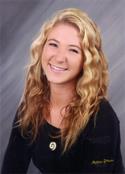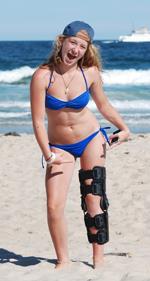Diseases & Conditions
Patient Story: ACL and Meniscus Tears

During tryouts for her school softball team, 14-year-old athlete April Potter jumped to catch a fly ball. She landed badly, severely spraining her left knee.
Four days later, April's older sister also sustained a knee injury, tearing her anterior cruciate ligament, or ACL. April's parents noticed that her pain and mobility were similar to her sister's, and were concerned that her injury was more severe than originally thought. "We brought April to a different doctor," her father Jeff recalls, "and ultimately learned she had torn her ACL as well."
Both sisters had ACL repair surgery on the same day by the same surgeon; April on the left knee, and her sister on the right knee. Both girls' ACLs were repaired using a hamstring graft technique. In this procedure, accessory hamstring tendons are harvested, braided together, and threaded through the heads of the thigh bone and shin bone to replace the ACL. The braided tendons are held in place by screws. Post operatively, the knee is immobilized to allow for maximum healing.
For an entire year, the sisters participated in the same physical therapy and rehabilitation protocol. However, April's recovery was longer and more complicated. On her first day back to activity after graduating physical therapy, April heard and felt the dreaded "pop" while running in a straight line in gym class. She had ruptured her ACL for the second time in a year.
The Potters traveled to Boston Children's Hospital to see Martha Murray, MD, an orthopaedic surgeon who specializes in ACL injuries. Dr. Murray reconstructed April's ACL and meniscus using cadaver ligaments. An allograft procedure, which uses donor tissue, is typically shorter than autograft procedure, which uses the patient's own tissue. "April's second surgery yielded a faster recovery and improved strength in a shorter period of time," Jeff says.

Fortunately, Dr. Murray's ACL repair was successful. After surgery, April did extensive physical therapy and continues to work with a personal trainer. "April can bear weight on her affected leg without pain and has more confidence participating in activities with the brace," her dad states.
April is working on redefining herself as an athlete and is thrilled to once again be involved in the sports she loves. Now a senior in high school, April coaches field hockey and basketball in her hometown recreation department, serving as a mentor for young female athletes.
"The ACL experiences illuminated the potential for a genetic predisposition for the girls in our family to experience an ACL injury," Jeff says. "We are now aware of the physiology and the posture of a female body in action and the danger of an ACL tear."
The Potters would like to see a national focus on ACL injury prevention and awareness programs for female athletes. "Research and development of new surgical techniques as well as advanced rehabilitation strategies will ultimately benefit the patient and society by helping the patient become productive and active sooner," Jeff says.
Last Reviewed
September 2014
AAOS does not endorse any treatments, procedures, products, or physicians referenced herein. This information is provided as an educational service and is not intended to serve as medical advice. Anyone seeking specific orthopaedic advice or assistance should consult his or her orthopaedic surgeon, or locate one in your area through the AAOS Find an Orthopaedist program on this website.






